Power line redfish in west Lake Pontchartrain are one of the most overlooked and underrated fishing opportunities in Louisiana. Specifically, the powerlines that stretch across the lake can make for easy, drag-peeling fun during the summer!

But when should you fish the power lines in Lake Pontchartrain? Why do so many people not fish it? What’s the best tackle to use and where can you launch from?
These questions and more are addressed in this guide. If you read the entire thing, then you’ll have inshore fishing knowledge that most do not have and will be set up for success to experience this great summertime fishing spot.
We’ll begin with the exact location of these powerlines:
West Lake Pontchartrain Power Line Redfish Coordinates
Also known as transmission towers, you will find these starting at 30° 2'35.43"N 90°14'1.84"W, as they run west toward LaPlace before turning north at 30° 4'56.58"N 90°24'8.56"W and running toward Pass Manchac.
I have found that any of these stretches can be productive for redfish, blue catfish and black drum, but my favorite is the row of transmission towers running from north to south.
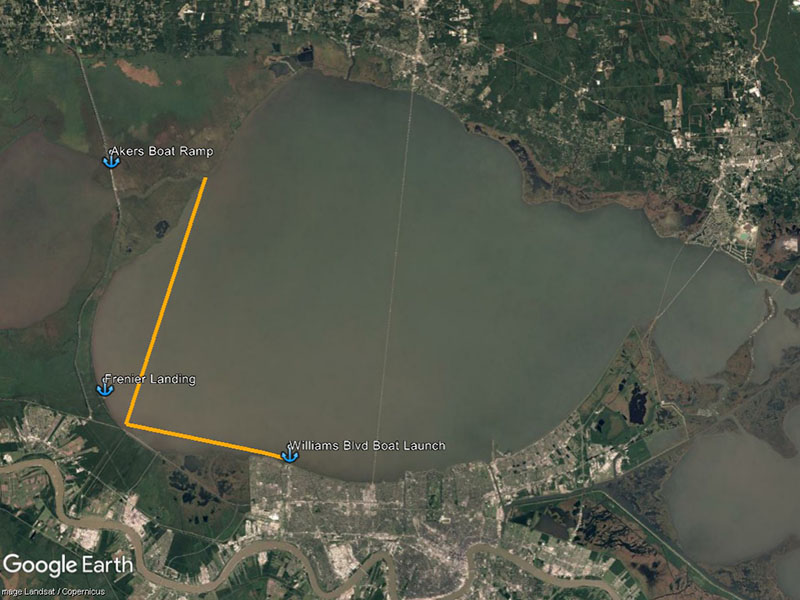
The Best Boat Launches To Fish The Power Lines
There are three boat launches you can use to take advantage of power line redfish:
- Williams Boulevard Boat Launch
- Akers Boat Ramp
- Frenier Landing
You should know something about Frenier Landing: the mouth of the canal leading out can get pretty shallow.
It’s nothing a bay boat or bass boat can’t get through, but on days with extreme low water you may find yourself needing to launch at one of the other two launches and fish there instead.
If you do have to cross the open water of Lake Pontchartrain, then be certain to make a good wind call and avoid rough water. This guide linked here details how to do that.
Why do so many anglers not fish this area?
By now you may be wondering why you don’t ever hear about the powerlines and — once you get out there — why you don’t see a lot of boats like you do at community holes such as the Trestles or Long Rocks.
And I think that’s because the powerlines is primarily a haunt for redfish and catfish. Speckled trout are far more popular and that’s what most of Louisiana’s inshore anglers launch their boats for.

After that, the above mentioned boat launches don’t have a lot of amenities, or any at all. Some people prefer to have a marina that sells live bait, has gas, clean bathrooms, and all that creature-comfort stuff.
The three boat launches listed above don’t have that, and the nearest marina that does —The Pointe Marina of Slidell — is a 30+ mile run across open water.
However, as you’ll see, you don’t need live bait to catch these fish. In fact, I feel that you don’t need live bait at all and this guide perfectly explains why.
So, with that out of the way, let’s take a look at what tackle you need to catch redfish at the powerlines in Lake Pontchartrain.
Preferred Tackle For Power Line Redfish
The tackle you already use for general inshore fishing is plenty, but it wouldn’t hurt to go a little heavier since you will most likely be dealing with upper slot and over slot redfish.
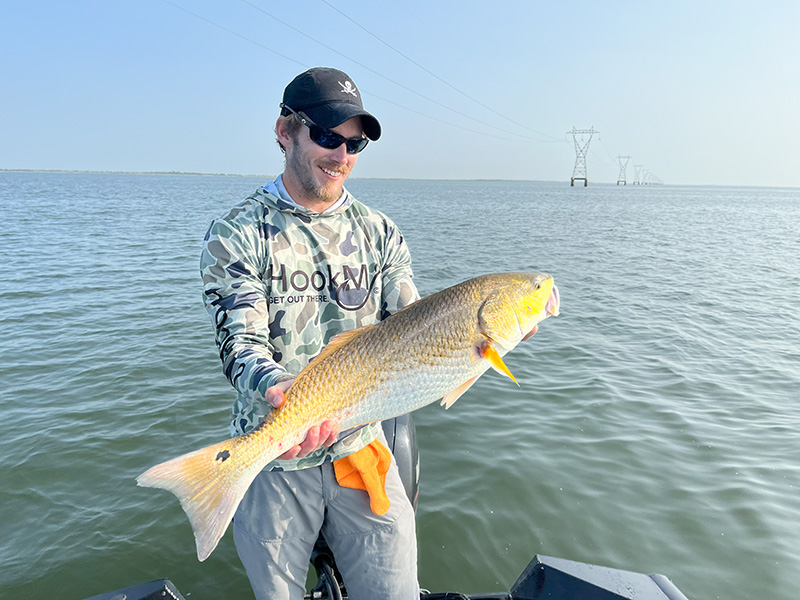
Most redfish out there are bulls, so you will want to have heavier tackle to easily fight them.
What you want to throw is a medium-heavy or heavy power fishing rod with a regular or fast action. A moderate action works, too. A seven foot to 7.5ft length is a good choice.
If these rod specifications sound like a foreign language to you, and you would like to learn what they mean, then I strongly suggest checking out my guide to choosing the best rod for inshore fishing.

After that, strong braided or monofilament fishing line is a good choice. I like to use 30lb braided line on spinning tackle and 20lb monofilament on casting tackle.
If you’re curious about reel size, a 3500 size spinning reel is plenty and a 150 to 200 size casting reel is more than enough as well.
A good lure to tie on would be a 3/8 oz jighead with whatever color soft plastic you enjoy. I know there’s a lot of fancy paddle tails out there — it seems like a new lure company crops up every week — but you really can’t go wrong with a 3” chartreuse sparkle beetle.
They’re tough, cheap, easily found in tackle stores and plain stand up to abuse, which power line redfish dish out in heaps.

But, to make that sparkle beetle a little more appetizing and to (literally) pass the sniff test, I suggest giving it a coat of garlic scent. You heard me right! Garlic scent in a spray can is powerful and sticks to the plastic.
Just be careful with this nuclear-grade fish scent and remember to keep your mouth closed when spraying it (unless, of course, you enjoy the taste of semi-permanent garlic).
After that, it’s worth noting that a Heavy Drop Shot is a good choice, too.
Now that you’ve got a good handle on fishing tackle, let’s move on to when and how to fish the powerlines.

The Heavy Drop Shot is a great tool to fish deep. Click the link above for instructions to tie one.
When To Fish The Power Lines
You can fish the powerlines for redfish anytime it’s calm enough to do so. As you can see when looking at a map, these pieces of cover are in open water. You really don’t want to be out there when it’s rough, especially in a smaller boat.
But I wouldn’t bother visiting just because the wind is calm. In the past, when I’ve successfully fished the power lines and caught redfish, it was only after a light wind had blown out of the west for an extended period of time.

That's a lot of open water susceptible to wind from almost any direction. Plan your trip carefully!
This allowed the west side of the lake to clear, making for good redfish action.
So, I would look at fishing that location during summer when a light west wind has been blowing.
Because it tends to get hot, I would launch first thing in the morning, especially if the water temp is hovering around 89-90 degrees or higher. Evening trips are doable, but morning is best.
The absolute worst time to fish power line redfish would be when the wind is cranking out of the east at 20 knots. It’s just not going to be safe to fish out there.
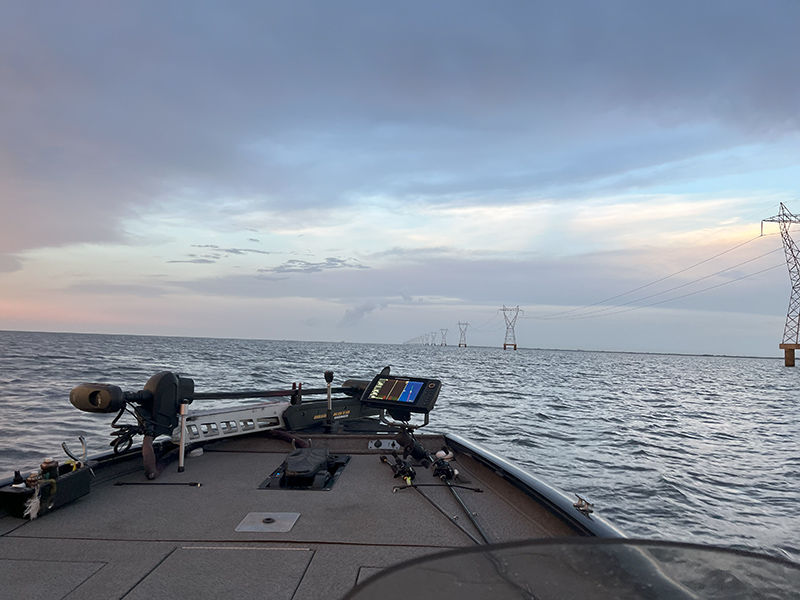
You don't need a big 24ft bay boat to fish these powerlines, but you do need to pay attention to the wind and sea state.
How To Fish The Powerlines
In theory, catching redfish at the power lines in west Lake Pontchartrain is pretty straightforward: you pull up to within casting distance of the concrete bases, make a few casts and, if nothing happens, leave for the next one.
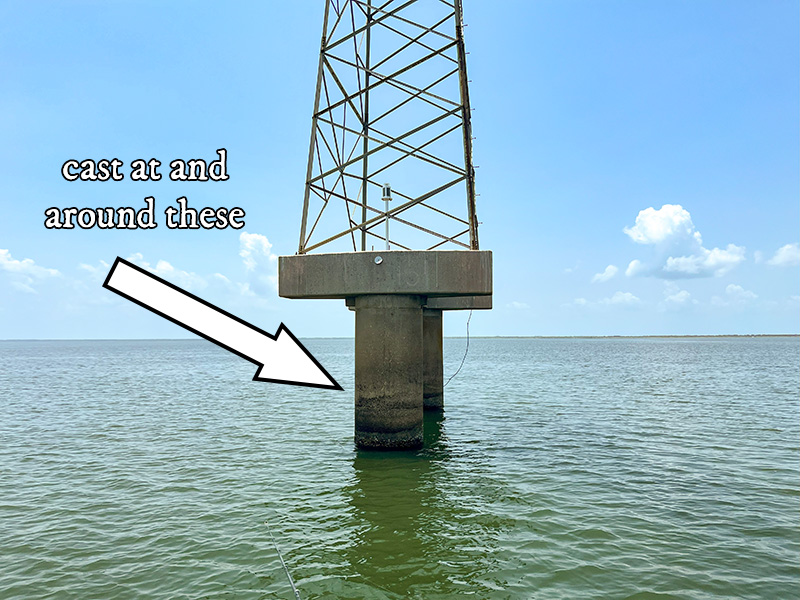
Rinse and repeat until you find power line redfish.
But in practice this can be daunting because there are literally hundreds of these concrete bases to cast at. Perhaps now you can better see why so many anglers avoid this challenge.
Just look at the picture below. You'll get tennis elbow from casting your rod 3,925,641 times before you catch your first redfish.

So how can you make the best of it?
Well, the first thing you need to do is ensure that your casts actually count. That’s because power line redfish are usually at the bottom of the water column, where it’s most difficult to get a lure in front of them.
If you can get a lure in front of them, then they are pretty much guaranteed to bite it. This is called getting a “good presentation”, and this free fishing course details exactly how to do that.

If you never get your lure to the bottom where the redfish are holding, then you will never catch them.
If the concept of presenting lures is news to you, then I highly recommend knocking out that course. It’s not long and it’s free.
Returning to the problem at hand: there are hundreds of concrete bases to cast at.
Well, assuming you can make quality casts and get good presentations on all of them, all I can say is “welcome to inshore fishing”.
Put that trolling motor in the water and get to work, homie.
Move with a purpose, cover water and you will eventually find them. Good luck.
But there are some high-tech tips and tricks I recommend using to make this endeavor astronomically easier.
Extra Tips & Tricks You Want To Use For Catching Powerline Redfish
Look, I do this for a living and enjoy a good fishing challenge, but remain particularly uninterested in unnecessarily punishing myself (like this trip to Breton Sound), so I’ve figured out how to make a good fishing trip to the powerlines that much more likely. We will start with sonar.
Using Sonar To Find Power Line Redfish
Sonar is not widely embraced in inshore fishing. As to why, I have no idea. But I use it a lot, having honed its use in the realm of bass fishing.
Yes, I’ve spent a non-trivial amount of time and coin going bass fishing in order to hone my fishing skills then bring them to bear on speckled trout and redfish. This endeavor has been incredibly rewarding.

And this is what I've learned: you will never look at sonar and wonder if redfish are there or not. This is because redfish are big and hard and give massive sonar returns, and especially a defined and crisp edge on side imaging sonar such as Humminbird’s MEGA Imaging.
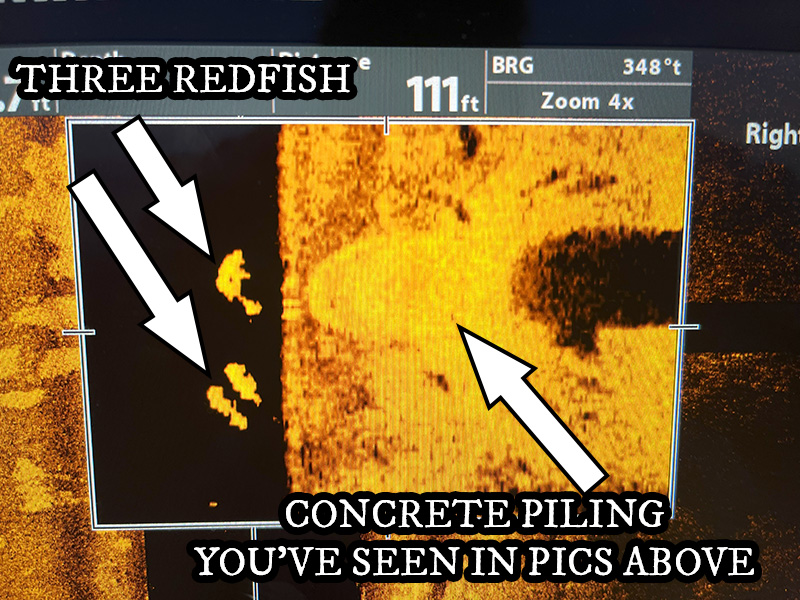
My favorite way to figure out where power line redfish are is to not fish the concrete pilings, but to graph them, which is a fancy $10 word describing the act of using sonar to identify what’s in the water.

I prefer to come off plane just before a set of concrete bases, begin graphing and — if I see redfish — drop a waypoint on the GPS to indicate that they are there and return later or — if there are no redfish — hop back on plane and do it all over again at the next set of concrete bases.
After I rack up a few waypoints, I turn around and fish them in a row. Wham, bam, thank you ma’am.

Using MODIS To Know When To Fish Power Line Redfish
Before any of this takes place I use daily satellite imagery to determine if it's worth going or fishing somewhere else. This way I can discern if the water in west Lake Pontchartrain is clear or not.
Then, all I need to do is make a good wind call (this guide show you how) and, if it looks calm, launch the boat and have fun!
If you have no idea what MODIS is, or don’t have years of experience using it (like I do), then I suggest checking out this article to get you pointed in the right direction. I personally wrote it and there you will find what you need to know to make the most of this valuable resource.
Dirty Lake Pontchartrain

Clean Lake Pontchartrain

How You Can Catch More Redfish In Other Fishing Spots Besides The Power Lines
The powerlines in west Lake Pontchartrain make for a fun fishing destination that you should enjoy, and now you know when and how to fish them.
That puts you light-years ahead of everyone else considering this hot spot but don’t have the knowledge that you found in this guide to give them the confidence to go.

And that’s what it boils down to:
Having the confidence to make your way into new fishing spots and know what to do in order to catch fish.
Well, I can tell you that there’s a process to finding and catching fish from scratch, anywhere on Louisiana’s coast. If you were to learn this process and master it, there would not be a single location you’d shy away from.
That process is what I teach inside my flagship course, Inshore Fishing 101. It’s only available inside LAFB Elite, my membership granting access not just to all of my courses, but also the LAFB Elite Community.
It’s where like-minded anglers post fishing reports and get help planning their future fishing trips. No Facebook, social media or extra logins are required to access this community, as it’s located right next to my courses on LAFB Elite.
If you’d like to learn more, then please consider watching this video or clicking the button below.
”
I really appreciate Devin's teaching & how he is "to the point" and down to earth, yet professional and gives a great presentation of what I need to know in order to catch speckled trout and redfish.
Before taking Inshore Fishing 101 I have not had very many successful trips to Louisiana, but with these great learning experiences, since completing 101, I have had more success. Finding the best conditions, using the right tackle, Google Earth Desktop & technical stuff on my Lowrance, etc., the list is too long for this, so THANKS from a rookie inshore fisherman!!!
Captain Devin has done an excellent job with these classes! As a speaker, preacher, college teacher, & singer I appreciate the research, experience, time, & knowledge he put into the great presentations of each class. I can not suggest any changes for such an excellent course!
Ira Burge / College Teacher
”
Inshore Fishing 101 is amazing, I’ve been able to add to so much to my knowledge base after completing it.
The way Captain Devin breaks down fishing concepts so they are easy to understand, as well as the optional quizzes, I was able to learn a lot more about finding and catching fish than if I were to watch YouTube videos or read magazines.
Very well done, Devin!
Terry Abreo /
If you have any questions, comments or something to add, then please do so in the comments section below.
Tight lines, and thank you for taking time to visit my website!

Thank you for coming back to the Blog! I hope I can continue to deliver. lol
Thank you so much, Al!
You’re welcome! And thank you for visiting my site. Be sure to look around, there’s tons of gems here.
Thanks for posting this! Living in Baton Rouge area it is a lot easier to make a trip to this side of the lake then to go to the marsh 2+ hours south.
Great article! Love the variety of it and it applies to so much.
More great fishing tips! Thanks for giving me the information.
It’s great when people leave a comment to let me know they visited. If you’d be so kind to do so, then that would be great. Thank you for your time and interest!